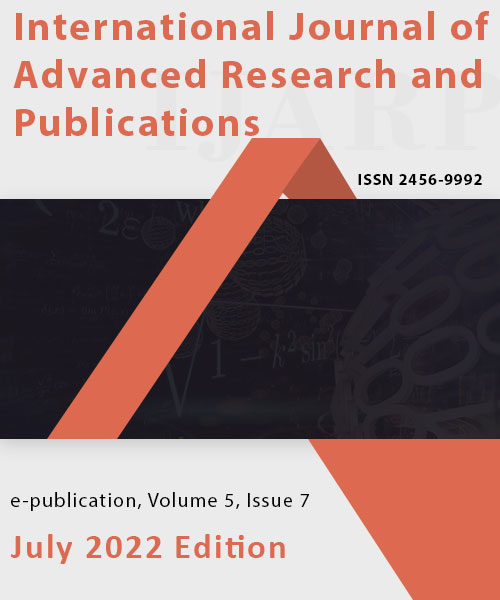Unpacking Students Chit-Chat In Messenger: Why English Is Missing In Action
 Volume 5 - Issue 7, July 2022 Edition
Volume 5 - Issue 7, July 2022 Edition
[Download Full Paper]
Author(s)
Jonalyn T. Abad, Joeza A. Aquino, Claire Joy G. Arcillas, Jasmin M. Clarianes, Rimma B. Datiles
Keywords
code-switching, instant messaging, learning community
Abstract
The demand for communicative competence in the English language motioned Communicative Language Teaching (CLT) approach’s inclusion in Mobile Assisted Language Learning (MALL) applications. Remarkably, several MALL applications enable users to communicate with other language learners and teachers, and native speakers worldwide through instant messages, and audio or video chatting. Likewise, instant messaging (IM) applications such as Facebook Messenger served as an avenue for communication for students. Both MALL applications and Facebook Messenger assist and enhance the learning of their analogous demographic through their similar features. If MALL applications and Facebook Messenger have comparable features and users, can Facebook Messenger foster CLT approach too? However, according to Appel and Pieter (1987, as cited in Besa 2013), an overview of the language situation must be obtained before any further steps can be taken. Henceforward, the study aims to unpack students’ chit-chat in the Messenger application to determine why conversational English is missing in action. The study employed Interpretative Phenomenological Analysis to present the lived experiences of fifteen English Major students situated in three existing group chats. The participants’ personal information is not to be disclosed in lieu of the Data Privacy Act of 2012. The recorded data from the observation and interview supplied responses and insights to the themes that emerged, the materialization of New London Group’s modes of communication, the language used by the students, and the circumstance of English in the students’ chit-chat. The study found that conversational English was underdeveloped and displaced by conversational code-switching. The pervasiveness of conversational code-switching can be attributed to actuation of the group chats as online learning community that promoted a shared context and natural language.
References
[1] V. Larsari, “Learners' communicative competence in English as a foreign language (EFL),†Journal of English and literature Vol. 2(7), pp. 161-165, available at http://www.academicjournals.org/ijel, September 2011.
[2] D. Darrin, “Mobile Assisted Language Learning (MALL),†educationalresearchtechniques.com, March 2015. Available: https://educationalresearchtechniques
.com/2015/03/10/mobile-assisted-language-learning mall/.
[3] M. Nushi, & H. Makiabadi, “HelloTalk: A Language Exchange App on Your Smartphone,†Roshd Journal of Foreign Language Teaching, 33(2), 16-23, February 2019.
[4] L. Besa, “Language Use in the University: A Clash of Policies,†Procedia - Social and Behavioral Sciences, Elsevier Ltd, 92-100, May 2014.
[5] E. Baraceros, Practical Research 1 (First Ed.), Philippines: Rex Book Store, Inc., 2016.
[6] J. Smith, & M. Osborn, “Interpretative Phenomenological Analysis,†September 2007. Available: http://med-fom-familymedresearch.sites.olt .ubc.ca/files/2012/03/IPA_Smith_Osborne21632.pdf.
[7] Edith Cowan University, “How to do a Video Essay: Modes, MultiModality & Multiliteracies,†Ecu.au.libguides.com, January 2020. Available: https://ecu.au.libguides.com/video-essay/modes- of-modality.
[8] S. Otto, M. Evins, M. Boyer-Pennington, T. Brinthaupt, “Learning Communities in Higher Education: Best Practices,†Journal of Student Success and Retention, October 2015.
[9] S. Timmis, “Constant Companions: Instant Messaging Conversations as Supportive Study Structures Amongst Undergraduate Peers,†Computers & Education, Elsevier Ltd, 59, 3-18, 2012.
[10] Lumen Learning, “Module: Multimodality, The Five Modes,†Lumenlearning.com, 2012. Available: https://courses.lumenlearning.com/olemiss-writing100/ chapter/the-fivemodes/#:~:text=The%20visual%20mod e%20refers%20to,its%20meaning%20on%20visual%2 0information.
[11] S. Lauricella, & R. Kay, “Exploring the use of text and instant messaging in higher education,†Research in Learning Technology, Vol. 21, 19061, 2013.
[12] C. Jewitt, Technology, literacy, learning: A multimodal approach, Abingdon, UK: Routledge, 2008.
[13] Oxford Languages, Code-Switching Meaning, 2019. Available: https://www.google.com/search?q=code+sw itching+meaning&oq=code+switching+meaning&aqs=chrome..69i57.7718j0j7&sourceid=chrome&ie=UTF-8.
[14] K. Shofner, “Linguistic Code-Switching: What it is and why it happens,†Unitedlanguagegroup.com, June 2016. Available: https://www.unitedlanguagegroup.com/blog/ linguistic-code- switching.
[15] J. Paolillo, “Conversational†Codeswitching on Usenet and Internet Relay Chat, Language@internet, 8 (3), 2011.
[16] J. Wong, & Z. Waring, Conversation Analysis and Second Language Pedagogy: A Guide for ESL/ EFL Teachers, Taylor and Francis, Hoboken, ISBN: 9780203852347, 2010.
[17] A. Feldman, “The role of conversation in collaborative action,†Educational Action Research, 125-147, DOI:10.1080/09650799900200076, 1999/2006.
[18] R. Buckmaster, “Using L1: What Kind of Sin?,†IATEFL Poland Newspaper, 2000. Available at: http://www.iatefl.org.pl/nletter/nletter18/nlet18_2.html.
[19] Z. Weigt, “Tłumaczenie na różnych poziomach nauczania języka obcego,†17th International IATEFL, Poland, 2008.